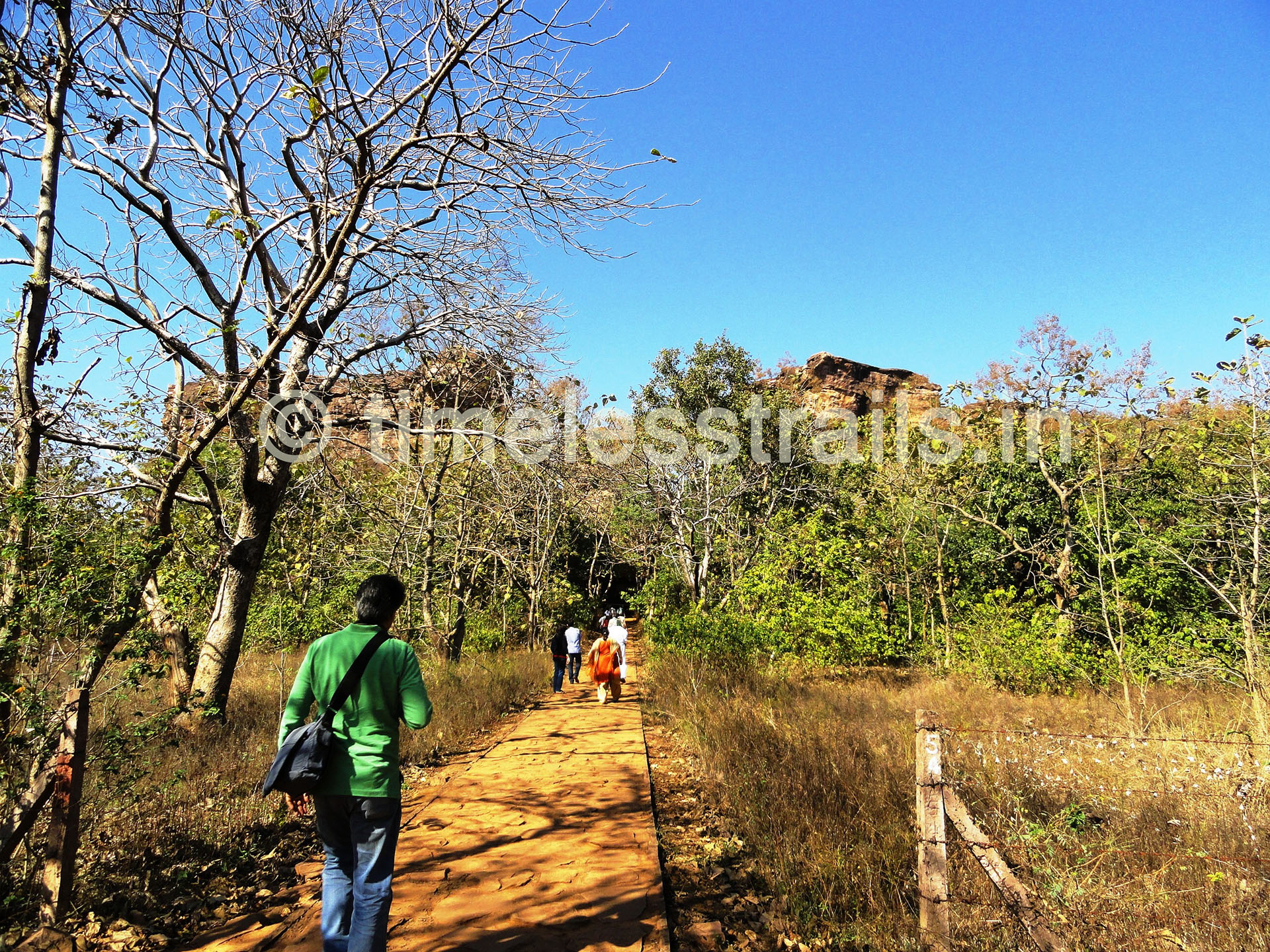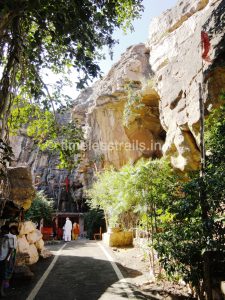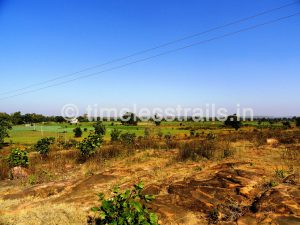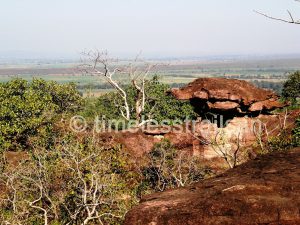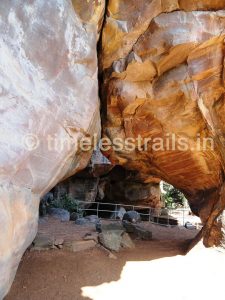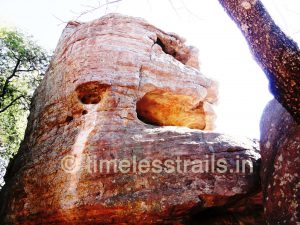Bhimbetka- Ancestors Terra firma
We drove past infinite, green, rocky slopes of the Deccan plateau, which seemed to culminate in the faraway backdrop of Vindhyan mountain range. To reach the Bheembetka Rock Art Cave-shelters, famed worldwide for primitive Rock paintings, spread over seven hills belonging to Paleolithic (Old Stone Age), Mesolithic( Middle Stone Age) and Neolithic (New Stone Age) periods, we had to cross them all. A wedding in Bhopal, Madhya Pradesh brought me to nearby Bhimbetka- the Stone age ancestors ‘Terra Firma”.
Bhimbetka- Beyond History
Escorted by the official guide of Archaeological Survey of India we set out to explore the Caves of Bhimbetka; which is the largest group of prehistoric Rock-Art cave shelters that bears resemblance to similar sites in Australia, Kalahari Desert and France. The guide informed us that sites like Bhimbetka are very rare in the world and are a testimony to the earliest traces of Stone Age man who inhabited India. According to a group of archaeologists, some of these shelters were inhabited 100,000 years ago! Indirect evidence suggests that the pebble tools found in the lower layer of the caves vary between 120,000 to 150,000 years! Could it mean that Homo erectus and Homo sapiens – the predecessors of modern man lived here?
The Temple
Before leaving for the Rock-Painting Cave Shelters we decided to halt at a large secret Cave inside a mountain that has Goddess Vaishno’s awe-inspiring temple. The history behind this is that it was set up by the Pandavas during their Agyatvaas (exile in hiding); as Maa Vaishno was their Kul-Devi. It is well maintained and a must see. The dimly lit cool interiors were a relief from the blazing sun outside. The name Bhimbetka, is derived from the name of one of the Pandavas-Bheem, from epic Mahabharata. Outside the Temple is a large Rock-seat that overlooks the entire valley, termed ‘Bheem ki baithak’or seat of Bheem used by him, while he was in exile.
Today, the importance of the temple is that the first bonfire of Holi is lit here and when it is spotted in the plains below, the rest of Holi festivities commence. It is also known for the annual Ram Navami fair.
The Cave shelters
A further drive from the Cave temple brought us to the entrance of the Rock Art Cave Shelters. A shining and engraved Brass plate announced Bhimbetka as UNESCO’s heritage site and more about its Rock Art. The Caves are in the natural environment, are not artificially altered and are what they must have been centuries ago. Accompanied by the guide, we set out to explore the Caves, numbered with large white signs. The guide cautioned our group to stay on the track marked below and defer from entering deep, dark caves for the fear of bats, snakes or scorpions.
I noticed that the sedimentary rocks of the Bhimbetka region have broken into ‘very smooth’ boulders of extraordinary shapes due to the weathering by wind and water, thus creating very even surfaces naturally. Shelters and large rocks of varying shapes and sizes have led the scientists to believe that the entire region was once under water – a sea bed, several thousand years ago!! In fact, the whole Vindhyachal range was under sea. As the water receded, these smooth textured rocks, caves and hills emerged.
The stopovers at the unusually named Cave shelters – The Auditorium or Sabha Grah, The Zoo rock or Jantu Shail Ashray, the Tiger Jaw, the giant Tortoise Rock and the Boar rock were memorable experiences as it is unexplained and a natural mystery as to how these rocks acquired shapes like animals! No wonder they are the most popular, photographed and filmed caves in the Bhimbetka tour.
We embarked on the Tour with the 20m high Rock-Shelter 1 whose prominent paintings are two elephants in white, the art period varying between 100,000 to 40,000 years! Also, we observed a baffling painting of a four legged, striped animal with horns and rectangular body.
A few steps away is the elongated, tunnel like Auditorium-Sabha Grah, Rock-Shelter number 3, that has engravings dating back to 100,000 years. Its newest art is the ‘only’ 10,000 years old Human-Handprint. Its size and shape is like an auditorium and at the end of the tunnel; hunters, deer, headless-tiger, cattle and stylized peacocks are displayed beautifully on the walls. On one end of the auditorium a 6000 years old skeleton had been discovered which can be seen in the Bhopal- museum. All paintings are done with ‘Geru’ or Haematite – iron oxide, used by the Tribals even today!
Appropriately named, Zoo Rock paintings; in Cave 4, as out of the 453 images, 252 display 16 species of animals alone!!They range between Mesolithic to Medieval period; the oldest is 10,000 years old and depict an array of animals that comprise Elephants, Bison, Sāmbhar, all varieties of Deer, Peacock, a Snake, some hunters carrying bows and arrows, soldiers with weapons along with the sun in the sky.
From the Zoo Rock, next we reached the Bheembetka viewpoint which holds an incredible panoramic view of the countryside below which was once a thick Jungle and Bheembetka Caves were Man’s refuge from the forest and animals. Its highlight is the mysterious Turtle Rock that looks exactly like a real Turtle altered into rock!
Subsequently, we photographed the tall Rock cave 8 shaped like the Tiger’s open Jaw. Its ceiling holds an interesting depiction of Horse riders with swords in bright red colour.
In Rock Art of Cave 9, the guide pointed out that the colours yellow and green had been introduced! It holds paintings of the Gupt period when the concept of agriculture had evolved and belong to the last period of man’s stay in the caves, after which he moved into houses. Also noticeable is the vivid portrayal of realistic horse and curvaceous flower vases with flowers and vegetables.
Rock shelter 10 has faded paintings and the guide showed us the figures of Ganesha, Shivling and Nandi which could have been from a later historical period when worshipping commenced. Interestingly, we had not noticed any God figures in any other cave. Further, we saw bright magenta, blue and green colours on the outer walls of the Cave which was created due to the continuous rainwater reaction with the Mica in the rocks! It rendered a very upbeat and captivating look to this rock shelter.
We also passed a ‘Duplex cave’, nicknamed so because of the natural formation of two levels formed inside it like a modern day flat! It has a ground floor and a first floor that had offered shelter to 25 people, in the past.
Many halts and photographs later we reached Cave 12, whose main Painting was the Neelgaiand Deer Hunting. Also, a strange faded painting depicted one man performing a religious rite, I think, on another one lying down.
Next, we headed for the Cave 15 which holds the famous exhibit named- Boar Rock that is taken after the painting of a giant supernatural mythical Boar with oversized horns, many times the normal size, chasing humans. The Painting clearly reflects the fear which was being portrayed through it! Dated back to Mesolithic period, the painting was found to be restored several times, especially the design in the middle and upper part of the boar where water eroded the upper layer of paint, exposing the lower older design. Even the eye of the boar appears to be a later addition. Besides, three smaller versions of the Boar had also been painted in Cave 15, at different spots.
After this we entered Cave 11 whose main display was a faded battle scene with two prominent Horse riders in white.
Further, Cave 7 exhibited historical-period paintings with again horse riders and deer, in white, though the horses had peculiar geometrical figures created out of triangles. There is no superimposition here.
Soon our tour was to end with Cave 6 where we noticed with amusement that the leisure activities of modern man are not so different from his predecessors! Ancient Rock-art displays community life of that time with group dancing, drinking and playing musical instruments. White and red shades stand out in the paintings of this cave.
Much as I yearned for the adventurous tour to continue; all good things have a culmination and so did this one. We strolled back, sat in the caves and took more photographs. In the process I gathered some information about the forms, periods and pigments of the prehistoric Rock art of Bhimbetka, from our guide.
Atypical Rock Art- themes, forms and period
The Guide commenced with the themes of uncountable intriguing paintings that adorn the Rock Shelters and Caves, depicting the lives and times of people who lived in them. Rock art of Bheembetka depicts rituals of daily life, customs, communal dancing, drinking, child births and burials. A favourite theme appears to be hunting scenes and animals.
The Rock paintings added in the later period show domesticated animals like cattle, men sitting on an elephants; all of which indicate the evolution of mankind. The paintings display similarities to Madhubani and Warli art-form!
Another unusual Mesolithic painting that draws attention is the Trident holding wizard or Shaman, named the Lord of Dance by the celebrity, Dr Wakankar, who rediscovered these caves in 1957 and worked extensively on them. The masked dancer is so named as the Trident he holds is similar to Shiva’s Trishul.
There are different forms of Rock Art in Bhimbetka that were produced over thousands of years- Petro-Glyphs(engravings), Pictographs(painting on rock) and Rock- bruising (chipping off weathered rock surface to create a picture) to name a few.
Further, he categorized the unusual forms of Rock Art of Bheembetka into broadly seven sets on the basis of Period:
The First set of Drawings belongs to the upper Paleolithic Age which includes linear representations of animals. The colour mainly used is dark red.
The Second group of Paintings is from Mesolithic period showing the culture of Middle Stone Age – food gathering and typical tools (spears, pointed sticks, bows and arrows). Also displayed are human figures and hunting scenes, communal dances, birds, musical instruments which showcase more lifelike scenes. The Mesolithic paintings show change of pigments and tools from the Paleolithic period.
The Third set of Paintings fit in to the Chalcolithic period which was the transition time between Neolithic(New Stone Age) and Bronze Age; sometimes referred to as Copper age when both Stone and Copper were used. These paintings reveal the interaction of the cave dwellers with the agricultural communities of other areas and exchange of goods with them.
The Fourth and Fifth set of Paintings are from early historic period, created with use of red, white green and yellow colour. The fascinating paintings show riders wearing tunic akin dresses, another noticeable feature is religious figures enter during this period as they are depicted in the form of Tree God, Sky chariots and Yakshas.
Also, Inscriptions of the Maurya and Sunga periods on the Cave walls have been discovered and amongst the Cave shelters some Stupas too, have been found. Bhimbetka is situated within a region of Buddhist sites dating back to 3rdcentury BC.
The last two sets of Paintings are classified to the Sixth and Seventh period belonging to Medieval Ages like the ones in Cave 9, as mentioned above.
Pigments and Brushes
The Guide made interesting inputs apropos to the Pigments and Brushes used in the Rock Art of Bheembetka, that unmistakably proved the superior knowledge Stone Age man possessed!! The pigments used for colouring was obtained locally and the most used colours were white and red. The red colour or ‘Geru’ was made by combining hematite-iron oxide, found naturally in the earth of this region by the Tribals till today! When burnt, it gives variety of colours- yellow, brown, and orange. Bird droppings, Plant latex and Gypsum were used as the white pigment. Later Copper yielded the green colour.
To get transparent colour the pigment was diluted with water whereas wet opaque colours were created by mixing pigment with oil. Also wooden coal, animal fat, leaf extracts, vegetables and roots were used. Coloured pigments were mixed with binding agents like blood, plant gum and sap. The Rock paintings were done with finger tips and sometimes hand prints were made. Brushes were made out of fibrous plants, sticks and chewed sticks. Animal hair brushes were formed much later.
Few Extraordinary facts –
While walking back to the Car-park, I recollected that the colours of the Rock -Paintings have remained intact and is remarkable that these paintings have not faded centuries and yugas later! It is due to the oxide present on the surface of the rocks. Another peculiarity that I recall is that at times, a rock surface was used and reused without rubbing the old paintings, causing layer upon layer of superimposed paintings; sometimes upto 15 layers…..Strange –because the rest of the Cave walls were left empty! This left me amused as to what could have been the reason for the same. Also, noticeable is that the paintings on the ceiling, in the centre of the cave wall and those away from the edges are darker than the ones on the edges; probably the rain water and sunlight could not damage them.
We drove back to Bhopal, with haunting memorable moments of the mysterious Bheembetka, thinking of how little we had seen – There are 750 Rock Shelters and Caves in all out of which 560 exhibit Rock Art and we saw only 12, open to tourists. The extent of art they all held was worth a question of speculation!!
- Outside the Bheembetka caves
- Bheembetka Rock Art Cave Shelters, main entrance
- The Tortoise rock
- Rock Cave Shelter shaped like Tiger’s Jaw
- Communal Dancing in Rock Art
- Red colour from Haematite in Earth used for Rock Art
- Goddess Vaishno’s rock temple from Pandavas time
- The site of discovery of the 6000 years old Skeleton
- Family photograph at Bheembetka
